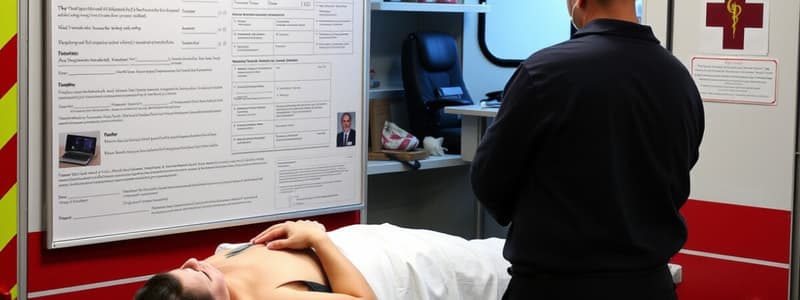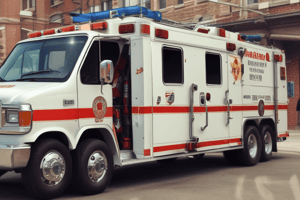Podcast
Questions and Answers
Which of the following documents is NOT acceptable as a DNR order?
Which of the following documents is NOT acceptable as a DNR order?
- Oral DNR Order from EMS System Medical Consultation
- Out-of-state EMS/DNR Form
- EMS/DNR Bracelet
- Advanced directives without a MOLST or DNR Order (correct)
How can an EMS/DNR Order be revoked?
How can an EMS/DNR Order be revoked?
- By notifying a government agency
- By obtaining consent from an authorized decision-maker
- By rewriting the original order
- By physical cancellation or destruction of order devices (correct)
What must EMS clinicians do upon receiving a verbal revocation of a DNR Order from the patient?
What must EMS clinicians do upon receiving a verbal revocation of a DNR Order from the patient?
- Immediately resuscitate the patient
- Inform a Base Station
- Document the revocation thoroughly (correct)
- Ignore the revocation if no device is destroyed
What is the primary criterion for not initiating resuscitative measures?
What is the primary criterion for not initiating resuscitative measures?
Who has the authority to revoke an EMS/DNR Order verbally?
Who has the authority to revoke an EMS/DNR Order verbally?
Which of the following statements about the EMS clinician's role in DNR Orders is true?
Which of the following statements about the EMS clinician's role in DNR Orders is true?
Which criterion allows EMS clinicians to pronounce death in the field?
Which criterion allows EMS clinicians to pronounce death in the field?
What action should be taken if a patient is unresponsive and there is no visible DNR order?
What action should be taken if a patient is unresponsive and there is no visible DNR order?
What is required for an EMS clinician to honor a DNR request from an authorized decision-maker?
What is required for an EMS clinician to honor a DNR request from an authorized decision-maker?
What should be done before formally pronouncing death of a pulseless, apneic patient in a multi-casualty incident?
What should be done before formally pronouncing death of a pulseless, apneic patient in a multi-casualty incident?
What is the first action that BLS must take to confirm death?
What is the first action that BLS must take to confirm death?
What must be documented after the pronouncement of death?
What must be documented after the pronouncement of death?
Which of the following is NOT a valid criterion for pronouncement of death in the field?
Which of the following is NOT a valid criterion for pronouncement of death in the field?
In the case of an obviously pregnant female patient, what should be done prior to any pronouncement of death?
In the case of an obviously pregnant female patient, what should be done prior to any pronouncement of death?
Which situation allows for EMS clinicians to terminate resuscitation efforts?
Which situation allows for EMS clinicians to terminate resuscitation efforts?
What is an important responsibility of EMS following a pronouncement of death?
What is an important responsibility of EMS following a pronouncement of death?
What is the correct administration method for epinephrine in infants under 5 years of age with mild symptoms?
What is the correct administration method for epinephrine in infants under 5 years of age with mild symptoms?
Which of the following symptoms indicate a severe allergic reaction?
Which of the following symptoms indicate a severe allergic reaction?
What is the maximum number of times albuterol can be administered for wheezing within a 30-minute period?
What is the maximum number of times albuterol can be administered for wheezing within a 30-minute period?
In which situation is intravenous administration of epinephrine acceptable?
In which situation is intravenous administration of epinephrine acceptable?
What is the appropriate dose of epinephrine for a 6-year-old child experiencing moderate symptoms?
What is the appropriate dose of epinephrine for a 6-year-old child experiencing moderate symptoms?
What concentration of epinephrine is appropriate for the intramuscular route in adults?
What concentration of epinephrine is appropriate for the intramuscular route in adults?
What can be administered as a rescue inhaler for moderate allergic symptoms in children?
What can be administered as a rescue inhaler for moderate allergic symptoms in children?
Which of the following symptoms is associated with the diagnosis of anaphylaxis?
Which of the following symptoms is associated with the diagnosis of anaphylaxis?
For pediatric patients younger than 5 years, what is the appropriate dose of epinephrine administered intramuscularly?
For pediatric patients younger than 5 years, what is the appropriate dose of epinephrine administered intramuscularly?
What is incorrect regarding the administration of epinephrine for less than 5 years old?
What is incorrect regarding the administration of epinephrine for less than 5 years old?
Which of the following is a sign of mild allergic symptoms?
Which of the following is a sign of mild allergic symptoms?
What should be done if blood pressure goals are not met at an epinephrine infusion rate of 2 mL/min?
What should be done if blood pressure goals are not met at an epinephrine infusion rate of 2 mL/min?
How long can albuterol be repeated after the initial dose for moderate symptoms?
How long can albuterol be repeated after the initial dose for moderate symptoms?
Which route should epinephrine never be administered via, except in specific emergencies?
Which route should epinephrine never be administered via, except in specific emergencies?
What is the correct initial action for managing a patient experiencing nausea?
What is the correct initial action for managing a patient experiencing nausea?
What is the appropriate dose of epinephrine for patients aged 5 years or older if using an auto-injector?
What is the appropriate dose of epinephrine for patients aged 5 years or older if using an auto-injector?
Which of these options is a possible symptom of gastrointestinal compromise in anaphylaxis?
Which of these options is a possible symptom of gastrointestinal compromise in anaphylaxis?
Which of the following is NOT an indication for nausea/vomiting management?
Which of the following is NOT an indication for nausea/vomiting management?
What rating scale is used to measure a patient's pain level?
What rating scale is used to measure a patient's pain level?
Which position should a patient be placed in if experiencing nausea?
Which position should a patient be placed in if experiencing nausea?
For mild to moderate pain, what is the pain rating range according to the scale?
For mild to moderate pain, what is the pain rating range according to the scale?
What is a common method to help manage nausea besides medication?
What is a common method to help manage nausea besides medication?
Which patient group is explicitly mentioned as needing analgesics?
Which patient group is explicitly mentioned as needing analgesics?
In which scenario would you NOT administer analgesics?
In which scenario would you NOT administer analgesics?
Flashcards are hidden until you start studying
Study Notes
Pronouncement of Death in the Field
- EMS clinicians can pronounce death when criteria such as decapitation, rigor mortis, decomposition, or dependent lividity are observed.
- Pulseless and apneic patients in multi-casualty incidents can be pronounced dead to allocate resources.
- Asystole must be confirmed by ALS before formal death pronouncement; exceptions include obviously pregnant females who require resuscitation.
- Document the time and location of the pronouncement, and notify law enforcement per local policies.
- Acceptable DNR (Do Not Resuscitate) orders must be verified before withholding resuscitation.
EMS DNR/MOLST
- In cases with acceptable DNR orders present, no resuscitation measures shall be initiated if the patient is in cardiac or respiratory arrest.
- Advanced directives without a MOLST or formal DNR order are not honored without EMS Medical Consultation.
- Revocation of a DNR order can occur through physical destruction of DNR devices or a verbal request from the patient, documented by EMS professionals.
Allergic Reaction – Pediatric
- Symptoms range from mild localized swelling to severe respiratory distress and loss of peripheral pulses.
- BLS guidelines for mild symptoms in patients under 5 years include administering a pediatric epinephrine auto-injector (0.15 mg IM).
- For patients aged 5 and older, the dose is increased to 0.3 mg IM.
- Moderate symptoms require the same initial treatment, with potential use of albuterol for wheezing.
Anaphylaxis – Pediatric
- Acute severe allergic reactions can manifest as urticaria, respiratory compromise, hypotension, and GI symptoms.
- Administer epinephrine based on age; under 5 years receive 0.15 mg IM; 5 years and older receive 0.3 mg IM.
- Albuterol may be used for wheezing or bronchospasm.
Nausea/Vomiting – Pediatric
- Indications for treatment include nausea, vomiting, and medication side effects.
- Position patient comfortably and consider spinal motion restriction if necessary.
- Inhale vapors from isopropyl alcohol wipes can help manage symptoms.
Pain Management – Adult
- Analgesic treatment is appropriate for patients with moderate to severe pain.
- Pain severity is rated on a scale from 1 to 10, where 1 is mild discomfort and 10 is extreme pain.
- Communication of pain levels can also be done using the FACES scale for patients who find it difficult to articulate their condition.
Studying That Suits You
Use AI to generate personalized quizzes and flashcards to suit your learning preferences.




